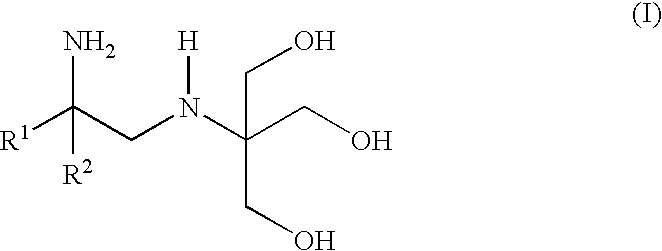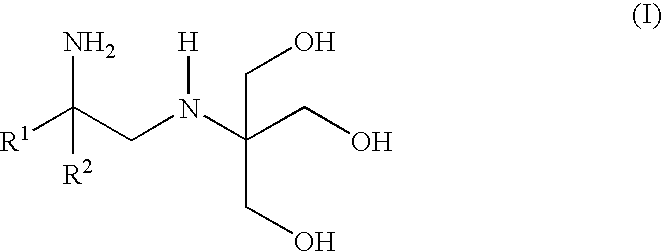Polyhydroxy-diamines as low odor, low VOC multi-functional additives for paints and coatings
a polyhydroxydiamine and additive technology, applied in the field of polyhydroxydiamine compounds and their use as low odor, can solve the problems of unsuitable low odor paint, poor scrub resistance, and high odor of such amines, and achieve the effect of reducing the content of volatile organic compounds
- Summary
- Abstract
- Description
- Claims
- Application Information
AI Technical Summary
Benefits of technology
Problems solved by technology
Method used
Image
Examples
example 1
Synthesis of 2-(Hydroxymethyl)-2-(2-methyl-2-nitropropylamino)propane-1,3-diol (TA-NMP)
[0039]A 2-L 3-neck flask is equipped with a mechanical stirrer, a reflux condenser with nitrogen blanket, and a heating mantle with a temperature controller and a thermocouple. The flask is charged with 238.3 grams (2.0 moles) of 2-methyl-2-nitropropanol (NMP), 242.4 grams (2.0 moles) of tris (hydroxymethyl)aminomethane (TA), and 200 grams of water. The mixture is stirred under nitrogen. An endotherm to 92%, with about 2.5% residual NMP present. IR, 1H- and 13C-NMR analyses are consistent with the desired structure.
example 2
Synthesis of 2-(2-Amino-2-methylpropylamino)-2-(hydroxymethyl)propane-1,3-diol (TA-AMP)
[0040]A 2-L 316 stainless steel Parr reactor is charged with 135 grams (0.61 moles) of TA-NMP, 500 mL of methanol, and 16.4 grams of water wet RaNi 3111 catalyst. The reactor is flushed with nitrogen, then pressurized with hydrogen. The reduction is conducted at 300 psig hydrogen at 40° C. The reduction is complete in about 1.5 hours. The reactor mixture is filtered to remove the catalyst; the filtrate is clear and pale blue in color. The methanol and water are removed from the filtrate by rotary evaporation to give 118 grams (100%) of viscous oil which crystallizes on standing. MP=73-75° C. GC analysis shows 91% TA-AMP, with about 9.1% of residual starting materials and / or byrproducts. GC / MS, IR, 1H- and 13C-NMR analyses are consistent with the desired structure. Titration gives pK1=9.9 and pK2=4.8. Volatility by the modified EPA Test Method 24 (described below) is 3.9%.
example 3
Synthesis of 2-((1-nitrocyclohexyl)methylamino)-2-(hydroxymethyl)propane-1,3-diol (TA-NCyHM)
[0041]A 1-L 3-neck flask is equipped with a mechanical stirrer, a reflux condenser with nitrogen blanket, and a heating mantle with a temperature controller and a thermocouple. The flask is charged with 127.4 grams (0.8 moles) of (1-nitrocyclohexyl)methanol (NCyHM), with 96.9 grams (0.8 moles) of TA, with 50 mL of methanol, and with 50 mL of water. The mixture is stirred under nitrogen until the solids dissolve, then the clear solution is warmed to 45° C. After about 4 hours at 45° C., an oil phase begins to separate, and after 12 hours the oil becomes a waxy solid. After 19 hours at 45° C., the reaction mixture is an off-white paste that is too difficult to stir. The reaction mixture is left to stand at room temperature for 10 days, then the solids are collected on a glass frit filter. The solids are washed on the filter with portions of hexanes. After drying, the yield of TA-NCyHM product i...
PUM
| Property | Measurement | Unit |
|---|---|---|
| melting point | aaaaa | aaaaa |
| melting point | aaaaa | aaaaa |
| temperature | aaaaa | aaaaa |
Abstract
Description
Claims
Application Information
 Login to View More
Login to View More - R&D
- Intellectual Property
- Life Sciences
- Materials
- Tech Scout
- Unparalleled Data Quality
- Higher Quality Content
- 60% Fewer Hallucinations
Browse by: Latest US Patents, China's latest patents, Technical Efficacy Thesaurus, Application Domain, Technology Topic, Popular Technical Reports.
© 2025 PatSnap. All rights reserved.Legal|Privacy policy|Modern Slavery Act Transparency Statement|Sitemap|About US| Contact US: help@patsnap.com



